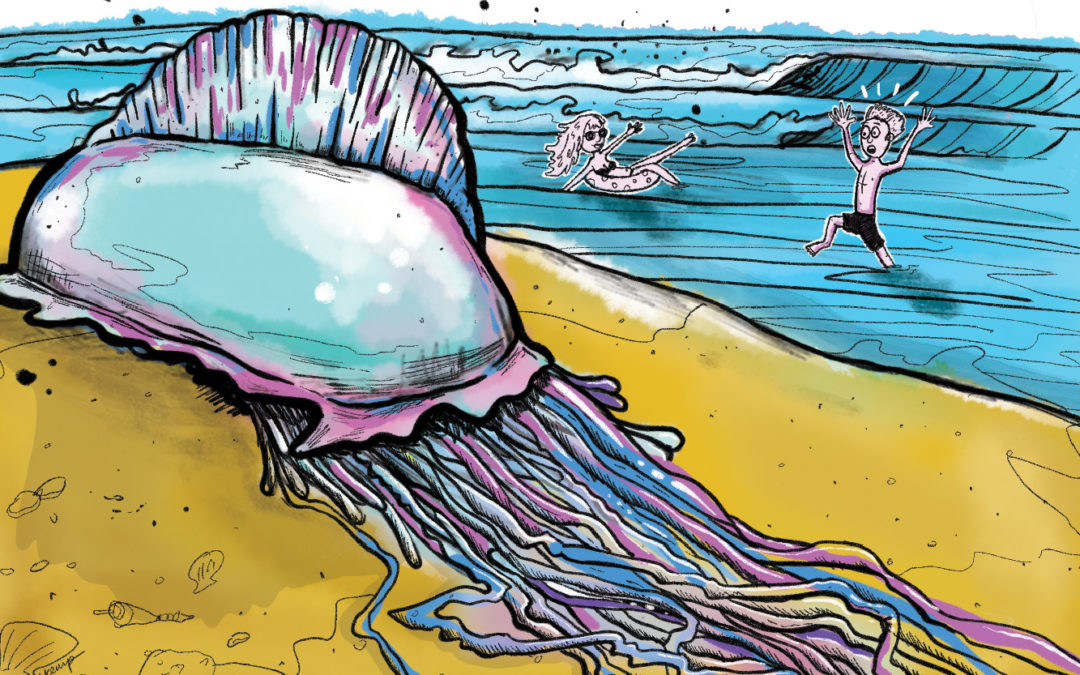Folly Fights Back Burning Invasion
by Lorne Chambers | editor
August may be the month when kids go back to school and tourist start to head home, but Folly Beach has swapped them both for something much worse: jellyfish and Portuguese man o’ war.
Last month, more than 700 jellyfish stings were reported along local beaches over a single weekend. Local hospitals reported hundreds of relief-seekers. And dreaded Portuguese man o’ war started washing up and floating offshores.
Isle of Palms got the worst of it, but could Folly’s number be up next?
According to the Charleston County Parks and Recreation Commission, county facilities on Folly Beach started seeing an uptick in stings in the middle of the month, but it was impossible to identify whether they were from jellyfish or from man o’ war, which are technically a different kind of floating menace.
There were 143 total jellyfish stings at the Folly Beach County Park from Aug. 10 to Aug. 19. But at the Folly Beach Pier, that number spiked up to 752 for the same 10 days.
YOWCH!
Folly Beach Public Safety Chief Andrew Gilreath, who oversees EMT responses on the beach, says that while he hasn’t kept strict numbers, that it sure does seem like there are more problems with “floaty-stingies” this year.
Gilreath says that while there have been more stings, he still hasn’t had to transport anyone to the hospital yet.
That gives credence to the idea that most of those stings were from jellyfish and not man o’ war, as those creatures pack a much, much more venomous sting and are actually a colony of organisms.
The state’s Department of Natural Resources said that because man o’ war float in ocean currents, they tend to be more prevalent in tropical waters. But strong currents and storms can bring them up the eastern seaboard.
DNR shellfish specialist Dr. Peter Kingsley-Smith says that there are “environmental factors — temperature and strength of the year class — as well as meteorological factors — like wind and currents — that could influence the abundance of jellyfish present in our coastal waters at a given time of year.”
DNR officials encourage locals and visiting beachgoers learn to recognize the Portuguese man-of-war so they can avoid it both in the water and washed ashore – even a dead man-of-war can be dangerous.
Dr. Robert Podolsky runs the College of Charleston’s Grice Marine Lab nearby on James Island. He says that while there has been no systematic study of jelly and man-of-war numbers locally, he said anecdotally there has certainly been more this year than in years past.
Man o’ war usually are more abundant around Florida and the British Isles, but there has been a surge into waters off Folly Beach. But what’s causing that surge?
Podolsky says that intuitively, ocean waters warmed by global climate change seems to be to blame. If that is the case, it seems to be in line with arrival of more species.
Porcelain crabs, which are studied and tracked at the marine lab he runs, have made a more “poleward” expansion thanks in part to more onshore currents spurred by warmer waters, says Podolsky.
Treatment for stings from jellies and man o’ war ranges from old wives’ tales to the scientifically proven. The trick is to remove the stingers, and some experts say use vinegar to get them to release.
But this was the first year county lifeguards have stopped carrying the kitchen staple. Most experts agree that doses of hot water to the affect area to flush out the stingers is key.
All the experts agree that the old wives’ tale of using urine to reduce the burn does not work. One, it doesn’t remove the stingers; two, it doesn’t lessen the burn; and three, and perhaps most importantly, it’s just gross.


